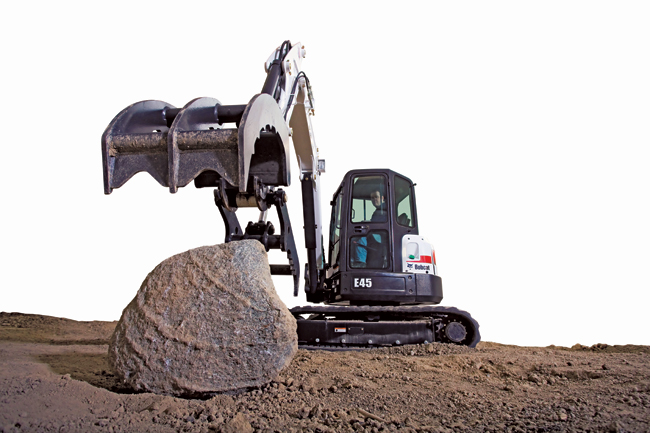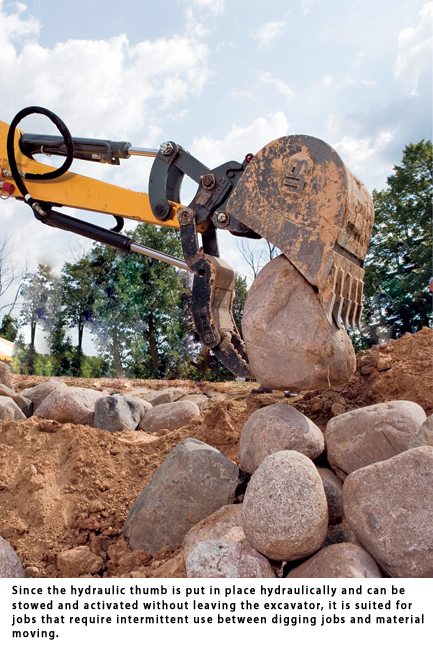Master Grip
When an operation calls for a long arm and a steely grip, a compact excavator and a grapple attachment create an excellent iron appendage. Equip a mini ex with a mechanical hand and you can grab, twist, pull and then precisely place dirt, debris, demolition or odd-shaped products and materials around the jobsite (from pipes to boulders to brush). Using a thumb, grapple or clamping bucket, contractors can diversify their small digging machines to pick and place objects with strength and accuracy.
“Well over half of all mini excavators already go out with thumbs on them,” explains Tom Connor, excavator product specialist with Bobcat, which offers plenty of thumb and grapple options on mini excavators). “There are regions of this country, like in the Northwest, if you tried to deliver a brand new excavator to a dealer without a clamp or thumb, they’ll say you may as well not deliver it.”
In today’s market, thumbs are one of the most popular options for a mini ex (excavators classified as 6 metric tons and below). Thumbs, or clamps, are the most cost-effective and easiest way to create a steel grip with your mini ex arm. Similar to the thumb on a human’s hand, the attachment is able to snatch items up and hold them firmly against the bucket. Operators can use thumb and bucket combos to handle a variety of applications such as lifting and placing timbers, rocks or debris, as well as aiding in tree, shrub and brush removal. Costing $1,000 to $4,000, a thumb can be self-installed (usually to the stick), but to avoid installing hydraulics, tubing hoses, cylinders and wires, a dealer installed or factory installed unit is a popular choice.
“Auxiliary hydraulics will be needed to operate most thumb attachments,” says Ron Peters, product manager with CEAttachments (a distributor of all types of implements including mini ex thumbs and grapples). “No minimum requirement flow is necessary as all compact excavators offer more than enough hydraulic power, but some machines may require a pressure relief valve installed in the mini excavator if it does not have one.”
A port or pressure relief valve is a protective device like a fuse (to put it in electrical terms). Envision grabbing a telephone poll horizontally with your mini excavator and thumb. If you tried to drive through two vertical poles — something has got to give — so the port relief valve allows the hydraulic pressure in the thumb cylinder to release its grip in overload situations.
“We categorize our mini excavator thumbs by operating weight and machine digging force,” explains Justin Croner, equipment specialist with Rockland Mfg. Co., an attachment manufacturer for the last 60 years. “We offer two types of mini thumbs, a hydraulic and a mechanical.”
Mechanical or rigid thumbs are also available (as opposed to hydraulic), but the operator must exit the machine to place the thumb in the desired work position. A mechanical link arm locks the thumb into place, allowing the thumb to work at a fixed angle to the bucket or to be stored against the excavator stick for regular digging work.
Oftentimes, thumbs paired with buckets don’t offer the appropriate grasp for bigger and more accurate job descriptions. That’s where a grapple or clamshell-styled bucket can come into play. The fixed grapple is the most popular style of grapple for compact excavators (two jaws — one with three tines and one with two tines — making a mechanical hand). The grapple reacts to the bucket curl, rolling out to open and curling up to grip timber, pipes, boulders, rocks, demolition and debris. This attachment may require that you weld a mount to the dipper arm of your excavator, allowing the operator to use the bucket curl cylinder to close the grapple. Sizes are often determined by the size class of the compact excavator (operating weight), but manufacturers often build fixed grapples with sizes from 24 to 36 in.
“Size and weight restrictions for grapples attachments are determined in the compact excavator’s owner/operator’s manual,” says Peters. “Just about any material can be picked up, however, thin walls, aluminum tubing, heating ducts or other light material may have a possibility of being damaged. These attachments can be used for placing large rocks along retaining walls and picking up and carrying pipes, culverts or scrap around a construction site. But these attachments should not be used for digging or prying, and demolition and forestry type applications may require additional operator protection such as a poly-carbonate front window, depending on the application.”
Fixed grapples can cost from $2,500 to $5,000 and are easily installed using the compact excavator’s universal quick-attach system. If you’re looking for something a little bigger, more maneuverable and more precise, then rotating grapples and rotating buckets are the ultimate, accurate iron fist on the jobsite. With multi-function capabilities and 360-degree rotation, a rotating grapple attachment allows a compact excavator to do precision landscape work or heavy-duty scrap and recycling applications, twisting the grapple on a rotator for quick and skillful pick ups and deliveries. Manufacturers like Bobcat even offer clamshell (or dirt) buckets and boulder buckets that go on their rotator, so that professionals can not only pick and place with precision, but also dig with the utmost accuracy.
“The dirt bucket will come together and mate together, so if you went down and clam-shelled into sand or dirt, within reason, it’s going to hold all that stuff in there,” says Connor. “The boulder bucket has crescents or half moons on each side of the buckets, and they’re much more conducive for scrap, brush and boulders, grabbing irregular-shipped objects.”
The rotating dirt or clamshell bucket can excavate and dispose of dirt, sand or gravel in a very exact manner, and a rotating boulder bucket can grip a myriad of awkward jobsite products and materials for perfect placement on your project. Rotating buckets and grapples are not cheap (they range in cost from $7,000 to $10,000), but for professionals who use them (utility, demolition, timber and landscape contractors), they will use this implement all day long in heavy-duty cycles. There are a myriad of other specialty grapples on the market: log grapples; unigrabs; felling heads; sorting grapples; demolition grapples; block manipulators; grapple saws; and pipe jaws. We suggest you explore the myriad of third-party attachment makers in the industry — like Valby (http://valbygrapples.com), Rockland Mfg. Co. (www.rocklandmfg.com) and Gater Grapples (www.gatergrapples.com). Regardless of the grapple you decide to buy, just make sure it can lift what you need it to lift.
“First thing I would do is look on my lift chart,” says Connor. “But in general, for compact excavators, I would say objects from 200 to 600 lbs you can lift. That’s a pretty wide spectrum. On the lift chart of my 3-ton excavator, I see a lift capacity of 800 lbs, less the weight of your attachment. And I always remind people, you’ve got the weight of the clamp [or thumb] out there too. The grapple isn’t really going to add anymore weight because you reduced your lift capacity by removing the standard bucket, but remember to include your clamp in the equation.”
Keith Gribbins is managing editor of Compact Equipment, based in Peninsula, Ohio.




Comments are closed here.